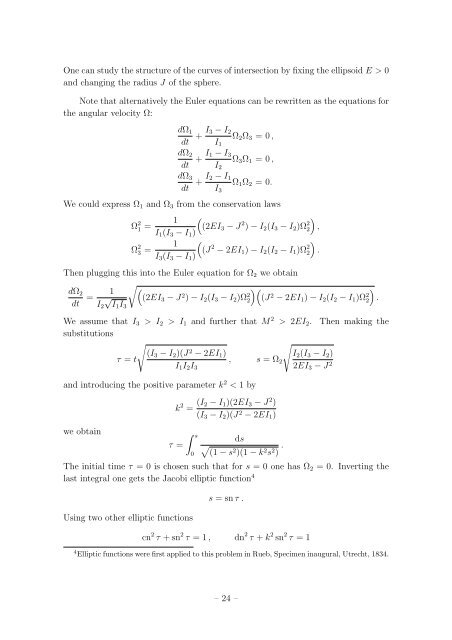Student Seminar: Classical and Quantum Integrable Systems
Student Seminar: Classical and Quantum Integrable Systems
Student Seminar: Classical and Quantum Integrable Systems
You also want an ePaper? Increase the reach of your titles
YUMPU automatically turns print PDFs into web optimized ePapers that Google loves.
One can study the structure of the curves of intersection by fixing the ellipsoid E > 0<br />
<strong>and</strong> changing the radius J of the sphere.<br />
Note that alternatively the Euler equations can be rewritten as the equations for<br />
the angular velocity Ω:<br />
dΩ 1<br />
dt + I 3 − I 2<br />
Ω 2 Ω 3 = 0 ,<br />
I 1<br />
dΩ 2<br />
dt + I 1 − I 3<br />
Ω 3 Ω 1 = 0 ,<br />
I 2<br />
dΩ 3<br />
dt + I 2 − I 1<br />
Ω 1 Ω 2 = 0.<br />
I 3<br />
We could express Ω 1 <strong>and</strong> Ω 3 from the conservation laws<br />
Ω 2 1<br />
(<br />
)<br />
1 =<br />
(2EI 3 − J 2 ) − I 2 (I 3 − I 2 )Ω 2 2 ,<br />
I 1 (I 3 − I 1 )<br />
Ω 2 1<br />
(<br />
)<br />
3 =<br />
(J 2 − 2EI 1 ) − I 2 (I 2 − I 1 )Ω 2 2 .<br />
I 3 (I 3 − I 1 )<br />
Then plugging this into the Euler equation for Ω 2 we obtain<br />
dΩ 2<br />
dt<br />
=<br />
√<br />
1 ( )(<br />
)<br />
√ (2EI 3 − J 2 ) − I 2 (I 3 − I 2 )Ω 2 2 (J 2 − 2EI 1 ) − I 2 (I 2 − I 1 )Ω 2 2 .<br />
I 2 I1 I 3<br />
We assume that I 3 > I 2 > I 1 <strong>and</strong> further that M 2 > 2EI 2 . Then making the<br />
substitutions<br />
√<br />
√<br />
(I 3 − I 2 )(J<br />
τ = t<br />
− 2EI 1 )<br />
I 2 (I 3 − I 2 )<br />
, s = Ω 2<br />
I 1 I 2 I 3 2EI 3 − J 2<br />
<strong>and</strong> introducing the positive parameter k 2 < 1 by<br />
we obtain<br />
k 2 = (I 2 − I 1 )(2EI 3 − J 2 )<br />
(I 3 − I 2 )(J 2 − 2EI 1 )<br />
τ =<br />
∫ s<br />
0<br />
ds<br />
√<br />
(1 − s2 )(1 − k 2 s 2 ) .<br />
The initial time τ = 0 is chosen such that for s = 0 one has Ω 2 = 0. Inverting the<br />
last integral one gets the Jacobi elliptic function 4<br />
Using two other elliptic functions<br />
s = sn τ .<br />
cn 2 τ + sn 2 τ = 1 , dn 2 τ + k 2 sn 2 τ = 1<br />
4 Elliptic functions were first applied to this problem in Rueb, Specimen inaugural, Utrecht, 1834.<br />
– 24 –

















